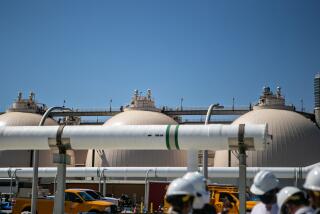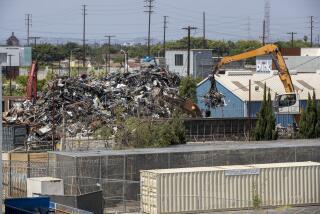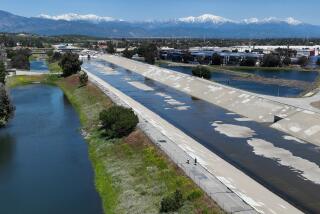Great Read: Environmental SWAT team tests runoff to nab polluters
It’s just after midnight when it starts to drizzle near downtown Los Angeles.
Lara Meeker, a short blond wearing a purple rain jacket, pulls into a fast-food parking lot a few blocks from the Los Angeles River, watches the sky and waits.
The watershed manager for Los Angeles Waterkeeper is tracking this late February storm by radar on her smartphone. Already, she has sent out a flood of text messages, maps and assignments to a small crew of environmentalists.
It’s going to be a long and soggy night monitoring the murky water sloshing off metal scrap yards, auto dismantlers and waste facilities in one of the biggest storms of the season.
Meeker, who heads the environmental group’s DrainWatch program, is overseeing a special corps of volunteers called Storm Water Assessment Teams — or SWAT — who fan out across the region to collect water samples in an effort to force polluters to clean up.
Whenever a storm hits and gutters start to gurgle, they pull on their parkas, headlamps and rubber boots. Working mostly after business hours or in the middle of the night, they make unannounced visits to lonely streets on the county’s industrial fringes.
Their work has a black-ops feel. As they bottle up dirty water, investigators keep a low profile, look over their shoulders and eye passersby with suspicion — and not without reason. Though they collect the samples from public sidewalks or streets, they’ve been chased off and even threatened by hostile property owners.
Targeted businesses often contest the results or complain about “bounty hunter tactics” aimed at extracting settlement money through lawsuits. But Meeker says it’s about holding them accountable.
“It’s one of the few opportunities we have to demonstrate the pollution that is coming from these facilities every time it rains and going unnoticed,” Meeker says. “If we’re not out there collecting samples and making a stand, then nothing will change.”
::
For a place that receives an average of only 15 inches of rain a year, Los Angeles has trouble handling all the water during a storm.
Much of the rainfall streams off the pavement, roofs and lawns of a sprawling urban landscape, sweeping a noxious soup through the region’s storm drain system, flood-control channels, creeks and rivers. Eventually it empties to the ocean, where the contaminants can foul beaches, sicken swimmers and harm marine life.
All of the county’s major waterways are listed as impaired under the federal Clean Water Act because they are polluted with toxic metals, bacteria, oil, grease and trash, and overloaded with algae-growing nutrients. Its beaches are among the dirtiest in the state.
Contributing to the problem are thousands of industrial facilities throughout the region that are required to monitor and limit polluted runoff from their property.
The Los Angles Regional Water Quality Control Board has only 10 full-time inspectors on its staff of 150 to police them all, and it uncovers more than two dozen unpermitted operations every year.
“We don’t get to some of these sites as constantly or as often as would be ideal,” says Samuel Unger, the board’s executive officer.
Unger welcomes the extra help and says some of Waterkeeper’s referrals have led to enforcement cases. “We take the information that they bring to us very seriously.”
::
Waterkeeper’s work starts with the first rainstorm of the season.
As it begins to sprinkle in October, two staffers from the group stoop over the slick pavement outside a huge recycling center in Chinatown, scooping black water from a puddle into a plastic bag.
On this afternoon, the facility’s workers snap photos of the investigators and thwart their sample-collecting by sweeping the water away from the street with a broom.
Next, the Waterkeeper staffers drive by several recycling yards they’re investigating. At one site, they slow down to take a photo from the passenger window.
“Hey, hey, hey!” the owner shouts at them as they pull away. He jumps in his car and tails them wildly through blocks of traffic.
At a red light, the man pulls up to confront them.
“You took pictures of my property,” the man barks out the window of his sedan. “Why?”
“It’s just from public property,” Liz Crosson, executive director of the Santa Monica-based nonprofit, replies from the driver’s seat. “It’s an experiment. Thanks,” she says before rolling up the window and making a right turn.
Many of the operations are family-owned businesses, and making upgrades to stem the flow of polluted water can be costly.
“It’s never our goal to put any of these yards out of business, contrary to what they might think,” Crosson says. “The problem is that so many of them are operating outside the law.”
::
With only seven full-time employees, Waterkeeper relies on dozens of volunteers to keep tabs on firms suspected of violating water pollution laws.
Meeker, 29, who has a master’s degree in environmental science, compiles a watch list using tips from community members, businesses and a telephone hotline. She works with a staff attorney to conduct drive-by inspections of businesses, collect public records about them and determine which ones lack permits, have a history of violations or otherwise warrant further investigation.
Sometimes Waterkeeper presents the facilities they investigate with a list of alleged violations and asks the companies to correct them. On other occasions the group, funded mostly by private foundations and individual donors, turns over its test results to water-quality regulators.
But their most formidable weapon is the 1972 Clean Water Act, which gives residents and environmental groups the power to take enforcement into their own hands and file suit to stop illegal discharges.
The lawsuits usually end in settlements, in which companies agree to make improvements. Businesses often pay for water-quality restoration projects to offset harm from their pollution and reimburse Waterkeeper for attorney fees and the cost of collecting and analyzing samples.
Over the last three years, Waterkeeper says, it has investigated 40 facilities, filed 14 lawsuits and settled eight cases.
But for the businesses scrutinized by the group, the surveillance and litigation can feel a bit like a shakedown.
“They came out in the middle of the night and took samples off our driveway,” says Doug Kramer, president of Kramer Metals, a scrap metal processor in the Florence-Firestone neighborhood of South L.A. “We completely contested their validity.”
Concerned over what it called excessive levels of copper, zinc and lead running off Kramer’s property, Waterkeeper eventually sued to force the company to either treat the water it was releasing or eliminate the discharges. Kramer fought the allegations.
After a five-year legal battle and a court order, Kramer and Waterkeeper reached a settlement.
To ensure that nothing flows off its property, the company built an extensive new storm water system. Workers installed new roofing to keep rain off piles of aluminum, stainless steel and wire that are sorted and processed in the 2-acre yard, put up additional containment walls and constructed an innovative $1-million infiltration system to clean oil, grease and metals from the water before it percolates into the ground.
Kramer says the upgrades protect him from future lawsuits, have made his operations more efficient and demonstrate that “businesses can operate within the law, they can be environmentally sound and still turn a profit.”
::
Back near downtown L.A., it’s approaching 1 a.m. and starting to pour.
Meeker pulls her car up to the gate of a metal recycler in a desolate industrial zone. She and a college student volunteering for the first time stretch on blue latex gloves and crouch below a spiked metal gate protected with razor wire and security cameras.
Under the glow of a streetlight, they lay dustpans into the runoff rippling onto the sidewalk to collect it before it spills into the gutter.
“That’s all flowing into the L.A. River,” Meeker says as they fill plastic and glass bottles of all shapes and sizes, to test for various pollutants, including oil, bacteria and toxic metals.
They label the bottles and place them in an ice-filled cooler. After visits to several other scrap yards, the investigators are soaked and monitoring is over for the night. Meeker drops off the samples at a state-certified lab in the City of Industry, where results later indicate they exceeded water-quality standards for aluminum, arsenic, copper, lead, pH and oil.
When the next storm blows in, she’ll be at a truck stop, diner or parking lot, waiting for the clouds to break open with rain.
More to Read
Start your day right
Sign up for Essential California for news, features and recommendations from the L.A. Times and beyond in your inbox six days a week.
You may occasionally receive promotional content from the Los Angeles Times.







